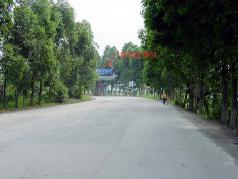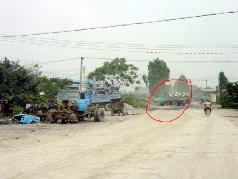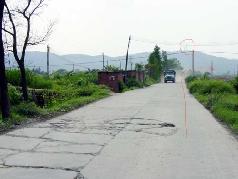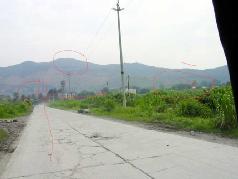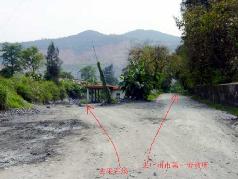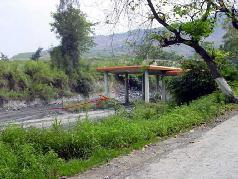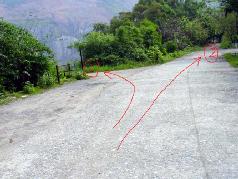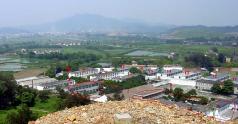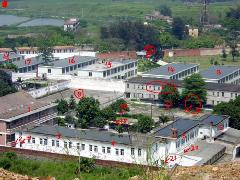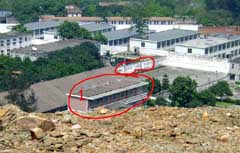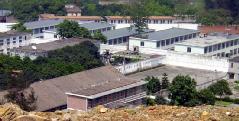(Clearwisdom.net)
The above is a view of the road taken by the long-distance bus from Liuhua Station in Guangzhou City, to Chini in Huadu District. After getting off the bus at Chini, one can rent a motorbike and go directly to the No. 1 Forced Labor Camp.
|
| 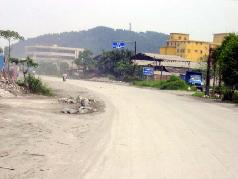 It takes ten minutes to get to the camp by tricycle. |
| 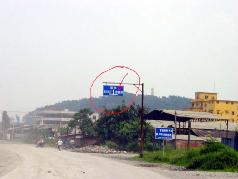 Once you get closer you can clearly see the sign, "Labor Camp." |
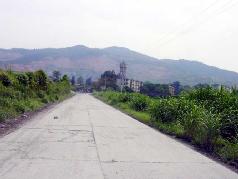
The mountain you see in the photo is the mining area, which borders the labor camp. It is a very important source of income for the labor camp. If you enlarge the photo you can see the grayish color. That is the color of the ore. At the end of the road you can see a small gate, which leads to the mining area. Passing this gate and going forward for about 50 meters, you can see a huge pit.
The arrow on the left points to the entrance to the mining area. The arrow in the middle points to the route towards the forced labor camp. The circle in the middle shows the famous Poluo Mountain in Guangzhou. The arrow on the right points to the area where the forced labor camp enslaves the inmates.
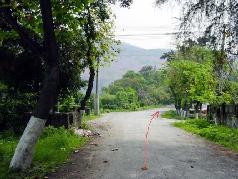
This is the direction towards the gate of the forced labor camp. Looking right at the end of the arrow you will see the main gate. To the left of the cement electricity pole is the huge pit.
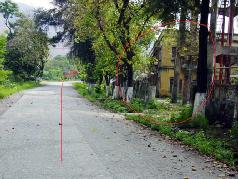
Some of these houses in front of the forced labor camp used to be occupied by the guards. Later, when the forced labor camp began to turn a profit off of the inmates' slave labor, it built new houses. The old houses are no longer occupied. Only occasionally some of the guards stay there.
Arrow no. 1 points towards the quarry. One can clearly see a huge pit. Arrow no. 2 points towards the main gate of the forced labor camp. This pit is very big. The diameter of the pit is several hundred meters. As shown in the next photo, before 2001 the No. 6 Division and the No. 2 Division of the forced labor camp were responsible for loading the stones by hand on the trucks. The guards with their dogs used metal whips made of finger-thick copper wire, or very thick wooden batons, to force the inmates to work harder. The guards behaved like slave drivers.
The forced labor camp has detained Falun Gong practitioners since 2000. It abolished the heavy manual labor to avoid public attention. Instead, it began to force the practitioners to do handicrafts for a prolonged time. The guards still talk about how "glorious" things were before that change.
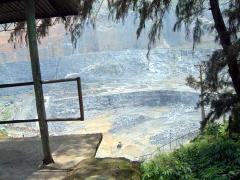
The pit is enormous. It's the size of a dozen soccer fields!
The next photo shows the front of the main gate of the forced labor camp, with our tricycle parked nearby. Owing to security, we did not get closer to the gate.
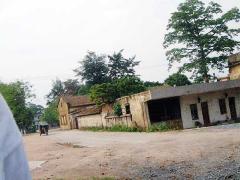
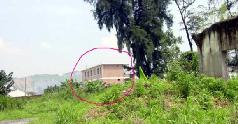
This is the photo we took from the back of the forced labor camp after we detoured through a small lane. It shows an area of the No. 2 Division, specially built to persecute Falun Gong practitioners. It is actually a 3-story building, which cost more than two million yuan (1) to build. The buildings in the photo are the living quarters of the guards. There are six rooms. Each night there are at least four guards on duty. There would be a deputy head or a higher up person to head the group, a guard who was in charge of ordinary inmates, and two depraved guards who were specially designated to deal with Falun Gong practitioners. Later on, the persecution of Falun Gong practitioners was carried out on the ground floor of this building.
This building was built in July and August of 2001 and was put into use around the beginning of 2002. When it was first built, the top floor of the building was the living area for the guards, the second floor was the office area and the ground floor was a "classroom." This was actually a place for study and entertainment for those former Falun Gong practitioners who renounced Falun Gong after being brainwashed. Every day, the depraved guards would force the Falun Gong practitioners to go there to watch slanderous videos and to read vicious materials intended to "transform" the practitioners. Two criminal inmates supervised these activities. By October 2002 the situation changed dramatically. The "classroom" was not used for "study" any more. It was divided into four to five small rooms with cement walls, and each room was fitted with an iron gate with a peephole. (The person inside the room was monitored from outside, but they could not see out of the room.) The forced labor camp was so desperate to escalate the persecution that it locked the practitioners into these rooms when the cement walls were still wet. The criminals used peepholes to constantly monitor the Falun Gong practitioners. Whenever they found that the practitioners wanted to go to sleep, or did not sit properly or performed the hand gesture for sending forth righteous thoughts, they would rush into the room and beat the practitioners. These criminals also observed the practitioners' every behavior and action, and reported them to the guards.
Those who had been detained in that building were not allowed to meet or talk to anyone, including the ordinary criminals. Steadfast practitioners were only allowed to use the toilet when other criminals had either gone to bed or were working in the workshops. The practitioners were also not allowed to sleep. As there was no chair in the room, the practitioners had to stand at all times. In each room there were three to five criminals. The depraved guards ordered them to keep surveillance on Falun Gong practitioners. These criminals adopted all kinds of cruel methods to torture the steadfast practitioners, including kicking and punching, beating with sticks and spraying with hot pepper water. The depraved guards used these methods to try to force the practitioners to renounce Falun Gong. If all such efforts failed within two days, the guards would use even crueler methods. The guards learned these methods during an autumn training session in Beijing. As far as I know, the guards who went to Beijing included the former Deputy Head of the No. 2 Division, He Guichao, guards Bi Dejun, Head of the Correction Division Zhou (given name not known) and guard Li Weicheng.
After October 20, 2002, the forced labor camp used these extremely cruel methods to deal with those Falun Gong practitioners who refused to renounce their beliefs. Li You was one of the practitioners who was tortured in one of the dark small rooms on the ground floor of the building. The director of the forced labor camp, Zhou Yangbo, and the political instructor, Li Guomin, selected a group of the most cruel and ruthless people from various divisions within the forced labor camp. These were mainly drug addicts or members of organized crime groups. In the evening, or during the day after the inmates had left for work, these criminals would drag Falun Gong practitioners to the bathroom of the confinement area. There, five to six hefty criminals would use a long cloth strip to tie the practitioners' hands first and then tie the arms under the armpit. That would stop the blood circulation in the arms. (The guard with a surname of Zhou said that he was able to make a practitioner renounce Falun Gong without using handcuffs and ropes. Now it becomes clear that he used cloth strips.) The depraved people would then bend the practitioners' arms back forcefully, cross their arms and tie them up with the cloth strip. This is an extremely painful torture. These criminals would do the same with the legs. They tied the practitioners' ankles and the top end of their thighs. Then they placed one leg on top of the knee of the other leg and tied them up with cloth strips. After that the criminals would place the other leg up as well. Because one leg had already been tied to the knee, it would be very difficult to pull the other leg up. However, they used a lot of force to do it and then tied it up with cloth strips. Then, two criminals at each side of the practitioner would pull the practitioners' feet in opposite directions. It would be tremendously painful and the legs would gradually become numb. Finally the criminals would push the head of the practitioner toward his legs and tie it down with the cloth strip from the legs. This would make breathing very difficult. Sometimes, the criminals would step on the practitioner's legs or tie a cloth strip to his hands, which were already tied up from the back, and hang the practitioner from a window frame. This would last from five to forty minutes. It was extremely painful for the victim. The blockage of circulation would make the victim's legs swell and become numb. It would be difficult to breath and one would feel mentally and physically exhausted. The majority of people are unable to endure such pain. Usually, terrible cries could be heard from that area. When the legs were untied half an hour later they were ice-cold. The untying was even more painful for the victim. After a while the depraved guards would tie their legs again and resume the torture.
Before tying up the practitioners, the depraved guards would hold Teacher's (the founder of Falun Gong) photos on which they printed some very dirty words and then they would stuff the photo into the practitioners' mouths, anus and privates parts, while whispering depravities into their ears. Thus, the practitioners suffered also a great deal mentally. Due to the excruciating physical pain and a breakdown in righteous thoughts, many steadfast practitioners yielded to the evil. Once they surrendered, the evil guards would repeatedly force the practitioners to do bad things. They printed a lot of Teacher's photos with dirty words on them. They would force these practitioners to write dirty words on the photos, swear at Teacher, and use a pen to scratch the eye of Teacher in the photos and burn the photos. The guards would take photos of all these actions, and then claim, "These are the evidence of your treatment of your Teacher. We will send these photos to Clearwisdom.net and see if your Teacher would still consider you as his student." In this way, many of the practitioners were forced to give in. It also explains the reason why at a certain period of time the rate of practitioners denouncing Falun Gong rose sharply. Some of the practitioners had been repeatedly tortured and even when they were unconscious the guards did not stop their torture. It clearly shows how evil these criminals are!
Those who were involved in the persecution of Falun Gong practitioners include:
Zhou Yangbo, the former Director of the No. 1 Forced Labor Camp
Li Guomin, Political Instructor of the No 2. Division
Bi Dejun, a guard
Li Weicheng, a guard, directly forced the practitioners to write the "Three Statements" (2).
He Guichao, Deputy Head of A Division, was in charge of instilling the practitioners with vicious thoughts.
Chen Fumin, a guard, was in charge of delivering documents and keeping a close watch on Falun Gong practitioners.
Hong Yuanpeng, a guard, was responsible for the daily administration work related to the persecution of Dafa practitioners.

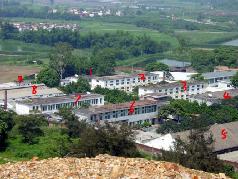
1. This is the clinic. One can see a very tall tree. The depraved guards often used this site to force-feed those practitioners who went on a hunger strike to protest the persecution.
2. This building houses the No. 3 Division, where Falun Dafa practitioners Luo Xiao, Shan Jincheng (no one knows their current whereabouts) and Luo Song were once held. The building that is close to the clinic is the workshop, producing spare parts for mechanical watches.
3. This building houses the No. 7 Division where Falun Dafa practitioners Zhang Mengye, Shen Wei, Liao Xiaohong and He Jianhong were held. In October 2002, they did not yield to the evil and walked out of the detention center with righteous thoughts. The products produced in the No. 7 Division were similar to those of the No. 3 Division.
4. This building houses the No. 1 Division where Shen Min (whereabouts unknown), Zhang Wenxue, Yang Ziren (whereabouts unknown), Yan Yong, Li Jiacong (in 2002 he was tied up and cruelly tortured for several days and nights. His righteous thought was very strong and he did not yield to the evil. By the end of the 2002, he left the forced labor camp), and Li Weiguo (whereabouts unknown) were detained. They mainly produced handicrafts such as plastic and cloth flowers. All these products were for export.
5. This is the workshop of the No. 5 Division. It was crowded with people producing plastic toys such as cartoon figures hanging on key rings. They specialized in producing colored drawings.
6. These are the prison cells of the No. 5 Division where Rao Zuoyuan (in August 2002 his neck was broken as a result of the cruel torture in this division. He died shortly after at Huadu Hospital), Li Guojun, Zhang Wenxue, Wu Zhiping, and Huang Dehua were detained. Wang Feng who was directly involved in the persecution of Falun Gong practitioners was transferred from this Division to the No. 2 Division.
7. This is the prison cell of the No. 8 Division. Practitioners Guo Zhimin, Li Zhenrui, Wang Keng and Lu Haiyun were held there. This Division produced handicrafts, and the living conditions were inhuman.
8. This is the workshop of the No. 7 Division. Since the building is made of corrugated iron, it becomes extremely hot inside when the scorching sun is directly overhead.
9. This is the confinement area where Falun Gong practitioners were tortured. Later on, all the tortures were carried out here mostly in the evening or at night.
In this photo, Buildings nos. 11, 12, 13, 14, 15, 16, and 17 are workshops that have been in use since 2003. Building 9 originally belonged to the No. 2 Division from 2000 to the end of 2001, and is now used by the No. 6 Division. Building 1 originally belonged to the No. 6 Division. At the end of 2001, a three-story building was constructed, and a special administrative division was set up.
From the photo we can see that No. 6 Division is unoccupied. This is because after the swap between No. 2 Division and No. 6 Division, the whole building of the No. 6 Division was seriously damaged and was on the verge of collapse. Therefore, the entire No. 6 Division moved to the workshop belonging to the No. 1 Division. The dining room and the canteen have been moved to the workshop of the No. 8 building shown in Photo 17.
Falun Gong practitioners Mr. He Kaiqiang, Mr. Chen Ruichang, Mr. Zhang Pan, Mr. Bao Diansheng, Mr. Zhang Wenxue, Mr. Shan Jincheng and Mr. Tan Weichan were held there.
From this photo one can clearly see the No. 2 Divisions, No. 6 Division and the square.
The rooms designated as no. 7 served as "classrooms" in 2000 and 2001 by the No. 2 Division. This is the place where Falun Gong practitioners were constantly bombarded with vicious brainwashing techniques. The mango tree (no. 11) and the kapok tree (no. 8) next to it were used to tie up Falun Gong practitioners. Many practitioners were tied up because of their protest against the persecution or when they became sober-minded after renouncing Falun Gong due to brainwashing and cruel torture. Mr. Bao Diansheng still clearly remembers the time when he was tied to the mango tree. In April 2002, Mr. Bao resisted the attempts to "transform" him, so he was thrown down to the floor by the head of the Correction Division, surnamed Huang, and guard Liang. They forced him to embrace the tree with two arms and tied him to the tree for two days. Criminals in the No. 6 Division, He Zhiming (currently held in the No. 2 Division.), He Zhihua and Zhang Guobang were all involved in the persecution of Dafa practitioners. These criminals were all locals from Huadu District, Guangzhou City. Those practitioners who were tied up to the kapok tree include Mr. Zhang Guoliang (he became sober-minded after having been forced to renounce Falun Gong) and Mr. Zhang Mengye. Many practitioners had been tied to the other mango tree (no. 10) as well.
The number 9 designates the drill grounds.
The blackboard marked by the number 12 is a tool for the propaganda. On it they posted information that viciously attacked Falun Gong.
The buildings marked no. 20, no. 3 and no. 4 were places where the No. 2 and No. 6 Division enslaved the practitioners. The building (no. 20) was made of corrugated iron, and was therefore very hot in summer. The practitioners were forced to work 20 hours a day in that building.
Building no. 6 is a canteen.
The places marked no. 2 and no. 19 were small cells, used to persecute Falun Gong practitioners. The window shown in no. 19 was the only window in that area. The forced labor camp reshaped the room in October 2002. This place served as the office for the so-called "People's Administrative Committee," where those key members of the former Falun Gong practitioners who had renounced Falun Gong after being brainwashed discussed how to "reform" other practitioners. The building was reinforced with concrete and fitted with iron gates and peepholes. This is the first area of persecution. Robust criminals dragged the steadfast Falun Gong practitioners there. After arriving there, they would be punched and kicked, forced to stand still against the wall for a long period of time, deprived sleep for several days and they were forced to copy articles slandering Falun Gong. If these tortures failed to work within a few days, the practitioners would be dragged to the confinement area marked no. 9 in Photo 17 for even more inhuman torture. Then they would be sent to the small confinement cells on the ground floor of the building marked 1 (you can see it slightly, near the location marked 2). There they were isolated and watched by the criminals selected by the guards. These criminals would use the cruel torture of tying up, beating and depriving those practitioners of sleep. Falun Dafa practitioner Mr. Huang Hehua, a second-year university student, had been tortured there for a long period of time and it is said that he suffered a mental collapse at the beginning of 2003.
During 2002, the No. 6 Division cruelly persecuted Falun Gong practitioners. The main perpetrators of the persecution were as follows.
Liang Yongkai, a political instructor, ordered criminals to cover the practitioners with books and then beat them with heavy hammers. This cruel torture would cause injury to the internal organs, without leaving any visible traces on the surface of the body.
Huang (given name not known), Head of the Correction Division, shouted at the practitioners, "It's better for you to die than me! I'm sure that I can make you renounce Falun Gong. I will hang you on a tree for seven days and seven nights!"
Yi Ming, a guard, provided criminal inmate Luo Guolin with several bottles of hot pepper spray and ordered him to spray the face, body, private parts, buttocks and other sensitive parts of the practitioners to force them to renounce Falun Gong.
A guard named Liang incited the criminals to daub a sugar mixture on the trees, in an attempt to attract ants to bite the practitioners who had been tied to the trees.
Criminal inmates directly involved in the persecution of Falun Gong practitioners include He Zhiming, He Zhihua, Zhang Guobang and Luo Guolin. These criminals were all from Guangzhou City.
|
|
|
Notes
(1) Yuan: Chinese currency, the monthly salary for an average Chinese urban worker is about 500 yuan.
(2) The Three Statements: Practitioners are coerced under brainwashing and torture to write these as proof that they have given up their belief. Created by the "610 Office" (3), the three statements consist of a letter of repentance, a guarantee to never again practice Falun Gong, and a list of names and addresses of all family members, friends and acquaintances who are practitioners.
(3) The "610 Office" is an agency specifically created to persecute Falun Gong, with absolute power over each level of administration in the Party and all other political and judiciary systems.




